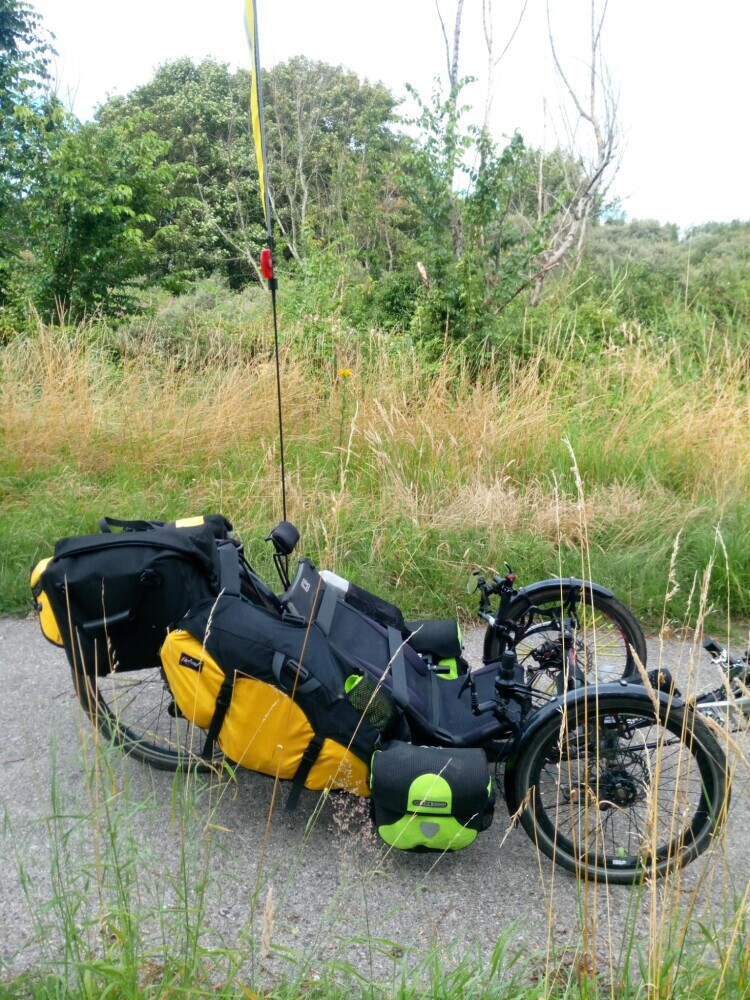📢Sleeping on a Recumbent Trike: When There’s Nowhere Else to Go🚴

🌱 Every seasoned trike tourer knows that life on the road isn’t always picture-perfect. Sometimes, when it gets late and there’s no better option in sight, the recumbent trike itself becomes the bed. It’s not luxurious, it’s not comfortable, and it’s definitely not ideal — but it works. In this post, I’ll share what it’s really like sleeping on a recumbent trike, how I do it, and why it’s one of those survival techniques every long-distance triker ends up discovering at some point.
✅ Real Talk: Sleeping on Your Trike When You Have No Choice
Late at night. Remote road. No campsite. No trees. No shelter. It happens.
And when it does, my recumbent trike becomes my backup bed.
I swing my legs over the front frame, slide into my sleeping bag, and rest my back on the trike seat. It’s not cozy, but when there’s no better place — no flat field, no bench, no tree cover — this setup becomes my lifeline.
No tarp. No tent. No clever DIY hacks.
Just my body, my sleeping bag, and my trike.
🔧 How I Make It Work – Raw and Simple
There’s no magic trick. Just a bit of adaptation and a mindset that says: “This will do for the night.”
Here’s what helps:
I keep a quality sleeping bag rolled up and easy to access. Warmth is everything when lying exposed.
I lean back, shift into a position where my back is supported by the seat, and stretch my legs across the main frame or boom.
If I have a thin mat, I tuck it under my hips or back for extra support.
I try to park out of the wind, behind a hedge, wall, or hill.
Yes, I’ve woken up stiff. Yes, I’ve been rained on. But I’ve also made it through the night when nothing else was possible.
💡 Things to Keep in Mind
This kind of sleeping setup is the last resort, not a planned solution. Still, a few things can make the experience slightly less grim:
Warmth first: Make sure your sleeping bag is rated for the temps you’re cycling through. You lose heat fast when you’re tired and exposed.
Foot placement matters: Keeping your feet across the frame gives just enough support to avoid cramping.
Minimalism helps: The fewer items you have to set up, the faster you’re asleep.
Visibility vs. Safety: If you’re in a remote area, it’s often better to be seen than to be hidden — especially if you’re near roads or traffic.
This isn’t about building a shelter. It’s about surviving the night.
🗂️ For Trike Tourers Who’ve Been There (Or Will Be)
This isn’t something you’ll find in travel guides or trike manuals. But every long-distance triker eventually hits that point:
The perfect camping spot was 20 (s)miles ago.
The weather turned.
Or you simply ran out of energy to keep searching.
Knowing that sleeping on a recumbent trike if you must is strangely empowering. It turns a cold, dark night into a lesson in self-reliance.
🚲 Gear That Helps When Sleeping on Your Trike
🛏️ Sleeping bag – Make it warm, compact, and easy to roll out quickly
🦶 Thin sleeping mat – Even a foldable foam pad makes a difference under your back or hips
🧦 Wool socks and layers – You’ll be lying still, so staying warm is key
🧢 Cap or head cover – Head warmth is body warmth
📱 Fully charged phone – Safety first, even when you’re roughing it
🔦 Headlamp – In case you need to move or reposition in the dark
You don’t need to carry a ton of gear. You just need to carry what works — when comfort is not an option.
❓ Frequently Asked Questions
Is sleeping on your trike safe?
If you’re in a quiet area away from traffic and have a charged phone, it can be safe enough. Always trust your gut about the location.
Is it comfortable to sleep on a recumbent trike?
No. It’s not meant to be. But it’s possible — and sometimes that’s all you need.
Should I plan to sleep this way?
Definitely not. But being mentally and physically prepared for this backup plan can save you in tough moments.
📅 Long-Term Trike Touring Strategies
Plan your camping options early in the day. Check your map. Be realistic about how far you’ll get before dark. But even with planning, be ready to adapt. Sleeping on your trike is not failure — it’s resourcefulness.
It’s the reality of long-distance, raw, wild touring.
🏁 Final Thoughts
Sleeping on your recumbent trike isn’t a badge of honor — it’s a sign of determination. When comfort isn’t available and options are gone, you improvise. You adapt. You survive the night, and ride on into the next day with stories in your legs and grit in your heart.
So next time you’re far from shelter, and the stars are your only roof — don’t panic. Just roll out your sleeping bag, stretch out on your trusty trike, and make the best of what the road offers.
And then? Ride on. One (s)mile at a time.

